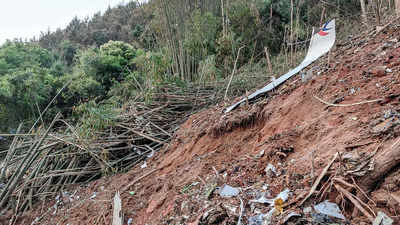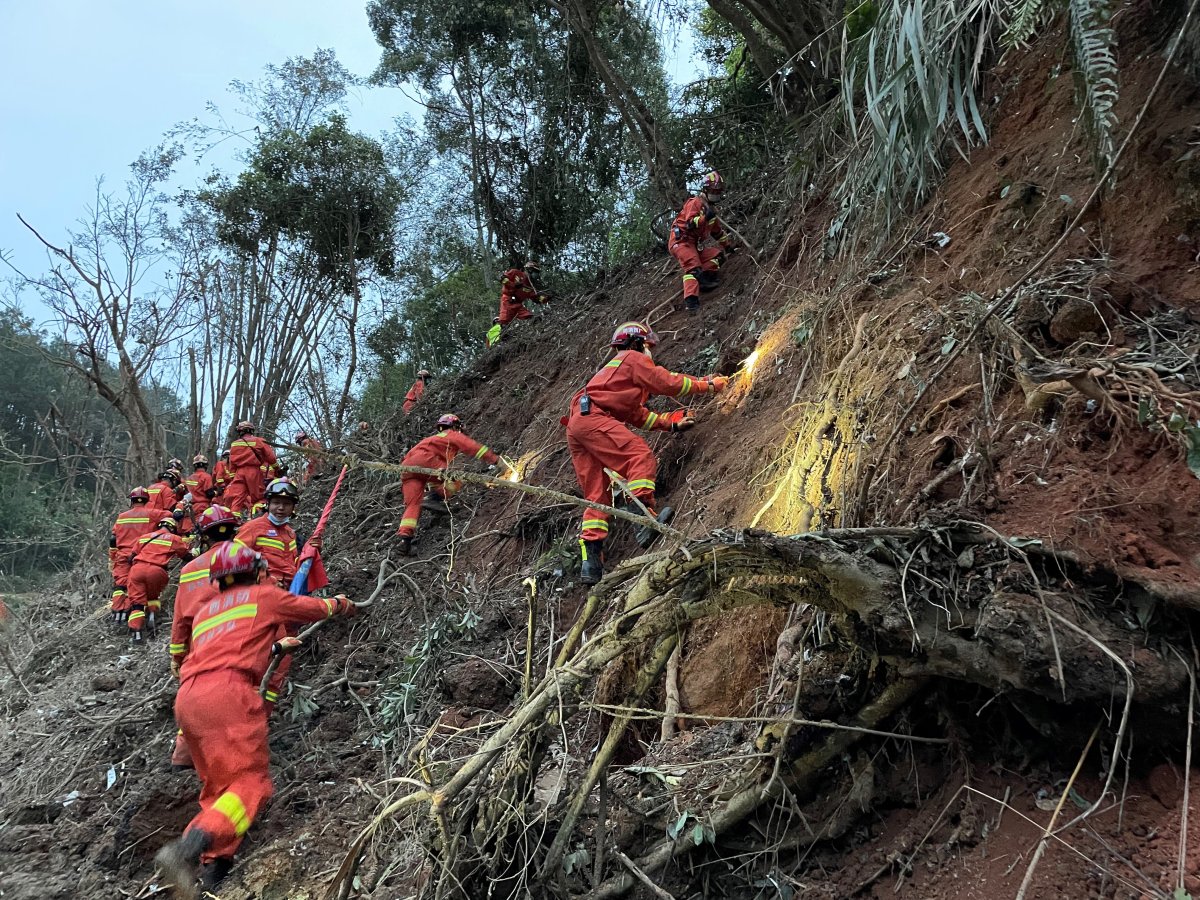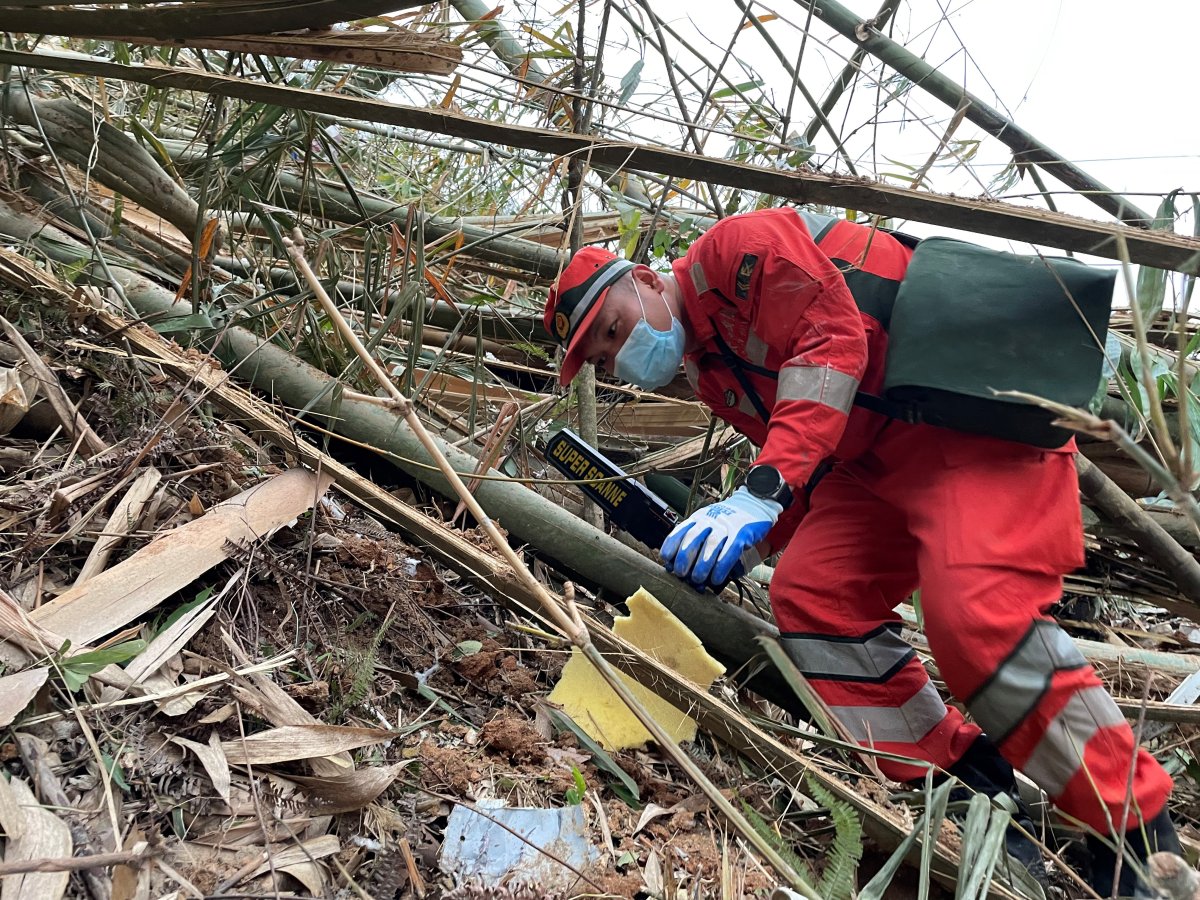
© Associated Press/Ng Han Guan
Several pieces of the China Eastern passenger jet that crashed in southern China, including one of its black boxes, were discovered Thursday.
In total, 183 pieces of the plane have been found by officials so far. Engine parts, cockpit items, personal objects belonging to passengers and human remains have been discovered, according to The Associated Press.
Black boxes in planes contain information and voice recordings from the cockpit between pilots, which could tell officials what went wrong causing the flight to crash with 132 people on board.
The black box found is believed to have voice recordings and was found largely undamaged, except for the outer casting, though its orange cylinder was mostly intact, the AP noted.
One of the items, a 1.3 meter-long fragment believed to be from the plane, was found 10 kilometers from the crash site, which encouraged officials to broaden their search area exponentially, Reuters reported.
There have been no survivors found and experts say that it is virtually impossible that anyone could survive the impact of such a fierce crash, according to the news service.
The investigation into the crash is being spearheaded by Chinese officials, though the United States is reportedly being invited to take part because the Boeing jet was manufactured and designed in the U.S.
Black box from crashed Chinese airliner discovered
The U.S. National Transportation Safety Board said that it has not yet been decided if investigators would go to China because of the country's strict visa and quarantine requirements and Chinese officials did not specify exactly when the American investigators would be invited, Reuters noted.
"Our work priority is still on search and rescue, and at the same time, carrying out evidence collection and fixation work in the early stage of accident investigation." Zhu Tao, a Chinese civil aviation administration official, said, according to Reuters.
Cockpit voice recorder from downed China Eastern Airlines being examined: officials
The search continued for the flight data recorder.
Debris from the jetliner including engine blades, horizontal tail stabilisers and other wing remnants was concentrated within 30 metres of the main impact point, which was 20 metres deep.
One 1.3 metre-long fragment suspected to be from the plane was found about 10 km away, prompting a significant expansion of the search area, officials told a news briefing.
No survivors have been found, and experts have said it was all but impossible that anyone could survive such an impact.
Flight MU5735 was en route from the southwestern city of Kunming to Guangzhou on the coast when the plane suddenly plunged from cruising altitude at about the time when it should have started its descent to its destination.
The investigation is being led by China but the United States was invited to take part because the plane was designed and manufactured there.
However, the U.S. National Transportation Safety Board said on Wednesday it had not determined if investigators would travel to China given strict visa and quarantine requirements, and Chinese officials declined to say whether or when NTSB officials would be invited.
“Our work priority is still on search and rescue, and at the same time, carrying out evidence collection and fixation work in the early stage of accident investigation,” said Zhu Tao, the CAAC’s head of aviation safety.
“However, when we enter the accident investigation stage, we will invite relevant parties to participate in the accident investigation according to relevant regulations,” he said.
Slow search
According to flight tracking website FlightRadar24, the plane briefly appeared to pull out of its nosedive, before plunging again into a heavily forested slope in the mountainous Guangxi region.
Authorities said the pilots did not respond to repeated calls from air traffic controllers during the rapid descent.
It was too early to determine the cause of the crash, which experts say are usually the result of a combination of factors.
“The difficulty now is that we are eager to search for survivors as soon as possible, but our work requires us to search carefully and slowly,” Huang Shangwu, deputy director of the Combat Training Office of the Guangxi Fire Rescue Corps said at the site.
Search teams used thermal imaging cameras and life detection devices as well as drones.
“The search area is really large, plus the two days of rain make the path very slippery,” said Zhou, among the more than 1,600 people involved in search operations on Thursday.
The flight’s captain had 6,709 hours flying experience, while the first and second officers had 31,769 hours and 556 hours, respectively, a China Eastern official said on Wednesday. One co-pilot was an observer to build up experience, the airline said, without disclosing the names of the pilots.
Phoenix Weekly magazine cited an aviation expert who identified the captain as Yang Hongda, the son of a former China Eastern captain, and the first officer as Zhang Zhengping, a pilot with 40 years of experience who mentored other pilots.
The Southern Weekly newspaper reported Yang, 32, had a one-year-old daughter, while Zhang, 59, was a veteran pilot with an impeccable safety record and had been expected to retire this year. Another media outlet, Jimu News identified the less experienced second officer as Ni Gongtao, 27.
China Eastern did not respond immediately to a request for comment on the reports
MU3735
Rain hampers search for remains, clues to China's fatal plane crash
Rough terrain and rainfall were hampering the search on Wednesday for clues into why a China Eastern plane inexplicably fell from the sky and crashed into a wooded mountainside earlier this week, presumably killing all 132 people on board.
Under rainy conditions, searchers using hand tools, drones and sniffer dogs were combing the crash site and a debris field spread across steep, heavily forested slopes in southern China for the black boxes containing the flight data and cockpit voice recorders, a well as any human remains.

Video clips posted by China’s state media showed small pieces of the Boeing 737-800 plane scattered over the area, some in green fields, others in burnt-out patches with raw earth exposed. Mud-stained wallets, bank and identity cards have also been recovered. Each piece of debris has a number next to it, the larger ones marked off by police tape.
Investigators say it is too early to speculate on the cause of the crash. Flight 5735 went into an unexplained dive an hour after departure and the plane stopped transmitting data 96 seconds into the fall.

READ MORE:
* Explainer: What is known about the China Eastern plane crash?
* China Eastern crash: ‘Foul play at the top of the list’ says air crash investigator
* No survivors found in crash of Chinese airliner
* China Eastern Airlines plane nosedived at over 840kmh into mountains, killing 132 people
It crashed on Monday afternoon outside the city of Wuzhou in the Guangxi region. The plane had been flying from Kunming, the capital of Yunnan province, to Guangzhou, an industrial centre not far from Hong Kong on China’s southeastern coast.
An air-traffic controller tried to contact the pilots several times after seeing the plane’s altitude drop sharply, but got no reply, a grim-faced Zhu Tao, director of the Office of Aviation Safety at the Civil Aviation Authority of China, said at a Tuesday evening news conference.

“As of now, the rescue has yet to find survivors,” Zhu said. “The public security department has taken control of the site.”
China Eastern is headquartered in Shanghai and one of China’s three largest carriers with more than 600 planes, including 109 Boeing 737-800s. China's Transport Ministry said China Eastern has grounded all of its 737-800s, a move that could further disrupt domestic air travel already curtailed because of the largest Covid-19 outbreak in China since the initial peak in early 2020.
The Boeing 737-800 has been flying since 1998 and has a well-established safety record. It is an earlier model than the 737 Max, which was grounded worldwide for nearly two years after deadly crashes in 2018 and 2019.
Monday's crash was China's worst in more than a decade. In August 2010, an Embraer ERJ 190-100 operated by Henan Airlines hit the ground short of the runway in the northeastern city of Yichun and caught fire. It carried 96 people and 44 of them died. Investigators blamed pilot error.
AP
China jet’s dive took it near speed of sound before crash
Bloomberg / Mar 23, 2022,

The China Eastern Airlines jet that crashed Monday was traveling at close to the speed of sound in the moments before it slammed into a hillside, according to a Bloomberg News review of flight-track data.
Such an impact may complicate the task for investigators because it can obliterate evidence and damage a plane’s data and voice recorders that are designed to withstand most crashes. One of the two black boxes was located Wednesday, officials in China said.
READ ALSO China plane crash: Black box found in damaged condition
“The preliminary data indicate it was near the speed of sound,” said John Hansman, a Massachusetts Institute of Technology astronautics and aeronautics professor who reviewed Bloomberg’s calculation of the jet’s speed. “It was coming down steep.”
Sound travels at 761 mph at sea level but slows with altitude as air temperature goes down and is about 663 mph at 35,000 feet (10,668 meters).
Flight 5735 was flying to Guangzhou from Kunming with 132 people on board at an altitude of about 29,000 feet when it began a sudden descent, according to data transmitted by the plane and captured by Flightradar24. The jetliner was cruising at about 595 mph before the dive.
READ ALSO China plane crash: Pilots did not answer calls
Pilots of a doomed China Eastern Airlines Corp. flight failed to respond to calls from air-traffic controllers after tipping into a deadly nosedive, authorities said. The jet was traveling at close to the speed of sound just before it slammed into a hillside, according to a Bloomberg News

“It was an exceedingly high-energy crash,” said Bob Mann, president of R.W. Mann & Co. consultancy, who did not participate in the speed analysis. “It looks like it literally evaporated into a crater.”
Chinese officials said Wednesday that the black box they had located was badly damaged, but didn’t say which one it was — the cockpit voice recorder or the one that captures flight data.
Modern black-box recorders, which store data on computer chips, have a good record of survival in high-velocity crashes, said James Cash, who formerly served as the U.S. National Transportation Safety Board’s chief technical adviser for recorders.
The circuit boards storing the data often break loose from the recorder’s protective exterior. But data can usually be extracted even if they’re damaged, Cash said before the black box was found.
“I would suspect it would be OK,” he said.
READ ALSO Chinese Boeing 737 plane crash in 7 pictures
The search for the remaining one won’t be aided by a beacon or “ping” from the devices because they are only activated underwater.
The two recorders on the China Eastern 737-800 were supplied by the aerospace division of Honeywell International Inc. and installed on the plane when it was new, according to company spokesman Adam Kress.
Crash investigators have over decades perfected the examination of wreckage in search of clues, but some impacts can obliterate evidence. The crash of an Ethiopian Airlines 737 Max in 2019 was traced back to a sensor on the plane’s nose, but the sensor was never found after the jet hit the ground at a high speed, according to a preliminary report from that nation.
Accident investigators should be able to find more precise speed data from the jet’s flight recorder. If it isn’t available for some reason, aerodynamic experts can perform extensive analysis to more closely estimate speed.
Flightradar24’s data includes the jet’s speed, but it’s measured horizontally across the ground. Bloomberg’s computations give a rough idea of how fast it was flying through the air by taking into account its horizontal speed over the ground as well as how fast it was descending.
The speed estimates were based on how fast the jet traveled between two points and didn’t take into account wind direction or other atmospheric conditions. The Bloomberg review was conservative and actual speeds may be higher.
READ ALSO Explainer: What is known about the China Eastern plane crash
While unverified videos showed the plane diving at a steep angle near the ground, it wasn’t clear how fast it was traveling at impact. The last data transmission captured by Flightradar24 occurred at about 3,200 feet altitude.
About 40 seconds before the last transmission, the jet stopped descending and briefly climbed before resuming the dive. During these later stages of the flight, it slowed somewhat, according to the preliminary review.
It was still flying far faster than normal. Typically, jets don’t go above 288 mph at altitudes below 10,000 feet. The China Eastern jet was traveling at roughly 470 mph or more at those altitudes, according to Flightradar24 data.




No comments:
Post a Comment